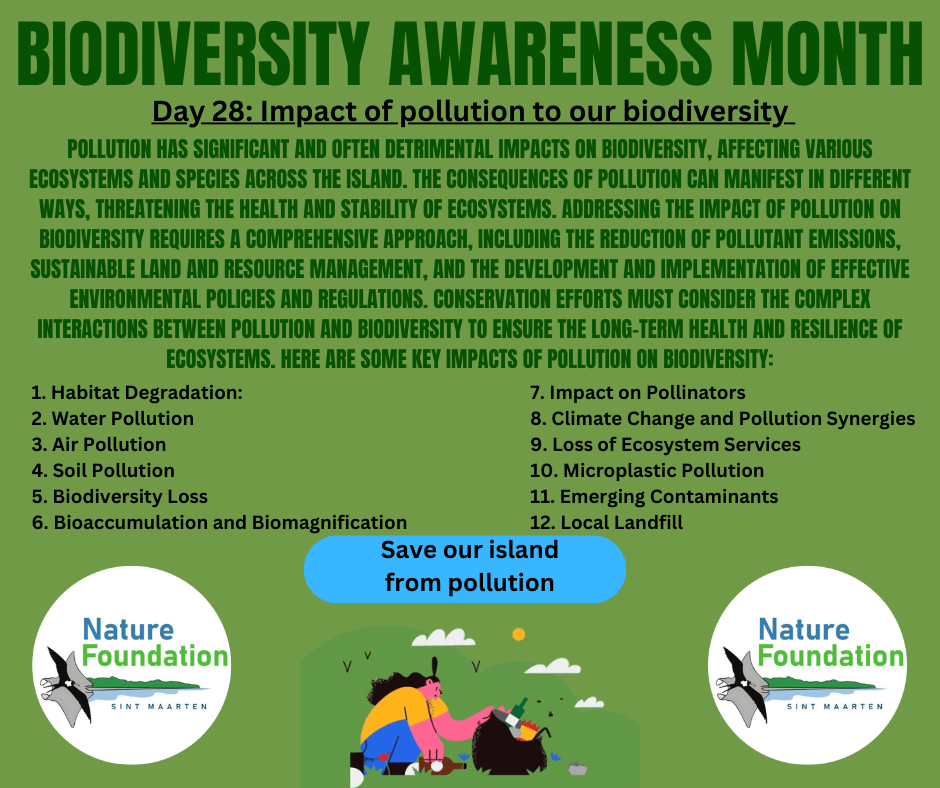Biodiversity month day 28: Impact of pollution to our biodiversity
The St. Maarten Hospitality & Trade Association supports the March Biodiversity awareness month organized by the Nature Foundation in an effort to help protect St. Maartens nature and biodiversity. Todays topic: Impact of Pollution to our Biodiversity
Pollution has significant and often detrimental impacts on biodiversity, affecting various ecosystems and species across the planet. The consequences of pollution can manifest in different ways, threatening the health and stability of ecosystems. Here are some key impacts of pollution on biodiversity:
1. Habitat Degradation:
Pollution can lead to the degradation of habitats, including soil, water, and air. Contaminants such as industrial chemicals, heavy metals, and pesticides can alter the physical and chemical properties of habitats, making them unsuitable for many species.
2. Water Pollution:
Chemical Contamination: Industrial discharges, agricultural runoff, and improper disposal of chemicals contribute to water pollution. Chemical pollutants can harm aquatic life, affecting fish, amphibians, and invertebrates.
Nutrient Pollution: Excessive nutrients from agricultural runoff or wastewater can lead to nutrient enrichment in water bodies, causing algal blooms. These blooms can deplete oxygen levels, leading to “dead zones” and impacting fish and other aquatic organisms.
3. Air Pollution:
Particulate Matter: Airborne pollutants, such as particulate matter and smog, can settle on vegetation and soil. This can interfere with photosynthesis, reduce plant productivity, and harm respiratory systems in animals.
Acid Rain: Emissions of sulfur dioxide and nitrogen oxides can lead to acid rain, which can acidify soil and water bodies. Acidification negatively impacts aquatic ecosystems, affecting fish, amphibians, and invertebrates.
4. Soil Pollution:
Contaminants in Soil: Pollutants from industrial activities, agricultural practices, and waste disposal can accumulate in soils. Contaminated soils can negatively affect plant growth, soil microorganisms, and the organisms that rely on them.
5. Biodiversity Loss:
Direct Mortality: Pollution events, such as oil spills, chemical spills, or industrial accidents, can cause direct mortality of organisms. This can have immediate and severe impacts on local biodiversity.
Indirect Effects: Chronic exposure to pollutants, even at low concentrations, can have sublethal effects on organisms, leading to reduced reproductive success, developmental abnormalities, and compromised immune systems. These indirect effects can contribute to long-term declines in biodiversity.
6. Bioaccumulation and Biomagnification:
Some pollutants can bioaccumulate in organisms. This means that as pollutants move up the food chain, their concentrations increase. This process, known as biomagnification, can lead to higher exposure levels for top predators, including humans.
7. Impact on Pollinators:
Pollution, including pesticide use, can have detrimental effects on pollinators such as bees and butterflies. Pesticides can harm their reproductive abilities, navigation skills, and overall health, leading to declines in pollinator populations.
8. Climate Change and Pollution Synergies:
Climate change and pollution often interact synergistically. For example, climate change can exacerbate the impacts of pollution, while pollution can contribute to climate change by releasing greenhouse gases. These interactions pose additional challenges for biodiversity conservation.
9. Loss of Ecosystem Services:
Pollution-induced damage to ecosystems can result in the loss of essential services they provide, such as water purification, pollination, and regulation of climate. This loss of ecosystem services can have cascading effects on human well-being.
10. Microplastic Pollution:
Microplastics, small plastic particles, have become a pervasive form of pollution. These particles can enter ecosystems, impacting aquatic life, soil organisms, and potentially posing risks to human health through the food chain.
11. Emerging Contaminants:
Emerging contaminants, such as pharmaceuticals and personal care products, can also enter ecosystems and have poorly understood impacts on biodiversity and ecosystem health.
Addressing the impact of pollution on biodiversity requires a comprehensive approach, including the reduction of pollutant emissions, sustainable land and resource management, and the development and implementation of effective environmental policies and regulations. Conservation efforts must consider the complex interactions between pollution and biodiversity to ensure the long-term health and resilience of ecosystems.
Back to the Visit St Maarten Main page

